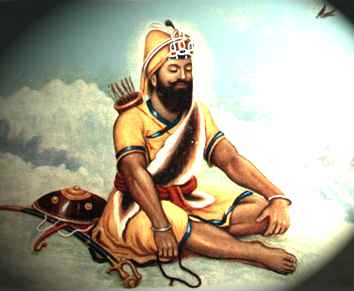
Guru Gobind Singh Ji meditating on the 'Hem Kunt' range of mountains, during his previous life - --- which he narrates in his autobiography "Bachitter Natak". In his narration he mentions his discourse with the Lord Almighty, who instructs him to be born to Guru Teg Bahadur, the ninth Guru in the lineage of Guru Nanak, and create the inimitable "Khalsa Panth". This narration and other 'Banis' of the Guru were collected by the Guru's most trusted and staunch sikh Bhai Mani Singh, who subsequently compiled the 'Dasam Guru Granth'. The 'Banis of this 'Granth' have been involved in constant controversy. However, the following letter of Bhai Mani Singh to Mata Sundari Ji (wife of Guru Gobind Singh Ji) clearly clarifies this subject that proves without any doubt that all the compiled 'Banis' of the "Dasam Guru Granth' are the genuine 'Banis' of Guru Gobind Singh Ji, and not of his poets.The original letter is given here with Punjabi and English translation.
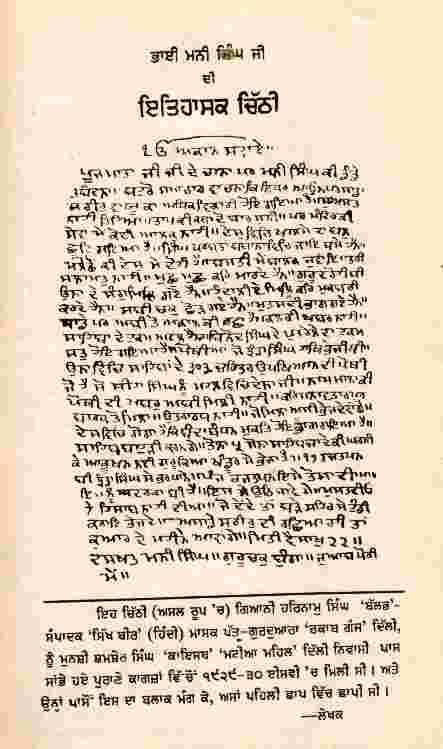
The Punjabi clear version of the above original letter

Bhai Mani Singh,a playmate, classmate and devoted disciple of Sri Guru Gobind Singh Ji , and a top -ranking scholar of his time. He survived the Guru by many years and was martyred at Lahore. This is an historic letter addressed by him from Amritsar to Mata Sundari Ji (the wife of Guru Gobind Singh Ji) at Delhi in April 1716. The English version of this letter runs thus:-
Letter of Bhai Mani Singh to Mata Sundari Ji
May the Almighty help us.
Mani Singh makes his humble prostration at the holy feet of his venerable mother. Further news is that the climate of this place has aggravated my rheumatism and my health deteriorates fast. I will have to listen to the healing parable of the tertian fever. But my illness has caused no slackness in the performance of the holy service of the Hari Mandir (Golden Temple). The Khalsa no more hods away over the country and its power has waned. The Sikhs have migrated to the mountain retreats. The Malechhas reign supreme in the country. There is no security for the (Sikh) children and women in any habitation. They are hunted out and killed. The opposing states have also joined hands with them. The Hindalis spy on the Sikhs. All (the Sikhs) have deserted the Chak (The earliest name of Amritsar). The Mutsaddis (priests) have also fled. So far the Immortal Lord protects me. Tomorrow is uncertain. What is ordained by the Lord shall prevail. The adopted son of Binod Singh has passed away. Among the books I sent per Jhanda Singh, there is one entitled "303 Chritra Upakhyans" by the Lord (Guru Gobind Singh). Give that to Sihan Singh in the Mahal (Matia Mahal in the interior of Delhi City). So far there is no trace of the book "Nam Mala". I found the first part of "Krishna Avtar" but not the second. I shall send it when available. There is a rumour in the country that Banda (Bahadur) has made his good escape from the Emperor's jail. May the Guru protect him. The Guru's family (the descendants of the Guru) at Khandur have sent five tolas of gold as a gift for your son's bride(an adopted son of Mata Ji, as all of her four sons were martyred already). Recover seventeen rupees from Jhanda Singh ; I gave him five rupees to meet the expenses of the journey…(?) These expenses will be incurred by him. The Mutsaddis have not yet settled accounts, otherwise I would have sent a draft from the city (presumably Lahore) . If my health improves I shall come in the month of assu.
Baisakh 22
Signed- Mani Singh,
Guruchak, Bunga
P.S. Reply in bamboo stick. (as being confidential)

Guru Gobind Singh, the scribe of the Dasam Granth
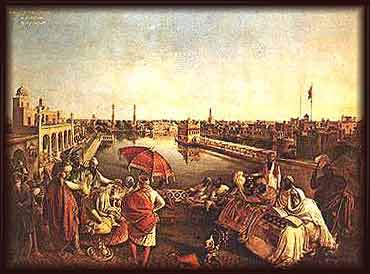
Maharaja Ranjit Singh listening to the 'Granth' being recited near the Golden Temple. Painting by August Schoefft (1809-1888), Vienna - from a sketch made by Schoefft in Amritsar - Princess Bamba Collection. There are two Granths lying side by side - one is Guru Granth Sahib and the other The Dasam Granth. Another thing worth noticing is that a canopy (umbrella) is adoring the Maharaja while the Granths do not have a 'Chanani' or anything similar.
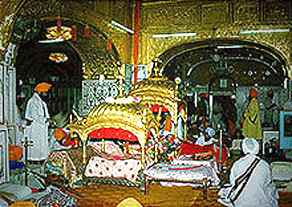 A
recent photograph of Hazoor Sahib, Nanded - where both the granths are revered
side by side.
A
recent photograph of Hazoor Sahib, Nanded - where both the granths are revered
side by side.
Reviews about the Dasam Granth
The 'Bani' of our Satgurus is very sacred to us, the Sikhs. It will be a great catastrophe if this belief is wavered by our dubious behaviour towards it. The bani of the Dasam Granth is par excellence and could not have been authored by any one else other than Guru Gobind Singh himself. The poetic style of Guru Gobind Singh is matchless and incomparable and none can compare with the phenomenal way Guru Ji has rendered his verses. The variations in the stanzas and poetical styles, which include all the nine modes of life (9 russ) can only be delivered by a great scholar of immense knowledge and immeasurable courage. The courage needed to expose the exploits of women in the "Charitro Pakhyan", so that the strong value system rules could be upheld and followed by the people, and a society free from all mortal sins could exist. I wonder if any of the scholars not agreeing with this would dare write on similar issues?
The Adi Granth and the Dasam Granth have both been revered equally ever since their inception. In the words of Kesar Singh Chhibber, the two Granths were like "real brothers"(see Legacies of the Sikh Past, J.S.Grewal, page20). The eighteenth century Sikhs had no qualms about the Dasam Granth and along with the Adi Granth was present at any meetings of the Khalsa, and was revered equally. Bhai Mani Singh accomplished the compilation of the Dasam Granth in AD 1713 five years after the demise of Guru Gobind Singh Ji.
Post Guru Gobind Singh period was the turbulent years for the Sikh Panth and the yeoman service Bhai Mani Singh did to the Sikh Panth, by collecting the Guru's Bani from Sikhs and whatever sources he could conjecture, in itself is a phenomenal achievement. This volume contains some specimens of the extraordinary style of writing and signatures of Guru Gobind Singh Ji, in Gurmukhi, Sanskrit, Braj and Persian scripts.
There are many points of historic, literary, military and political significance that can be enjoyed after a thorough study of this magnificent volume. There prevails a controversy within the panth regarding the authenticity of some of the Banis of Dasam Granth. However, Bhai Mani Singh Ji, a playmate, classmate and devoted disciple of Guru Gobind Singh Ji, and a top-ranking scholar of his time, who survived the Guru by many years and was martyred at Lahore, wrote this historic letter to Mata Sundari Ji (the wife of Guru Gobind Singh Ji) at Delhi in April 1716. This letter clarifies all the controversial points and solidifies the authenticity of the Dasam bani and the Dasam Granth. The original note in Panjabi and the English translation is given here.
Anyway some more proofs are available that the bani of the Dasam Granth was as much revered as the bani of Guru Granth Sahib. These two granths were always laid side by side in most Gurdwaras. An oil painting by a European artist August Schoefft done in 1850 from a sketch which he had made earlier during the reign of Maharaja Ranjeet Singh, depicts this in this painting. Another photograph recently taken at Hazoor Sahib, Nanded shows both these Granths lying side by side.
In the Spokesman weekly issue of July 1996, an article by Giani Gurdit Singh, states that on the birth celebration of Guru Nanak in 1942, two Akhand Paths were held at the Akal Takht. One Akhand path was of Guru Granth Sahib and the other of the Dasam Granth; both performed with full Gur maryada. An article further solidifies the authenticity of the banis of Guru Gobind Singh Ji in the Dasam Granth by Dr. Gurbhagat Singh, in the Khalsa Samachar of the 6th July 2000.
It is also known that eminent scholars assembled at the Akal Takht from 1892 to 1897, to study the various printed Dasam Granths and prepare the authoritative version. In this process, they determined that the Dasam Granth is entirely the work of Guru Gobind Singh.
Again in 1931, the Darbar Sahib Committee SGPC proclaimed the same and published a book to this effect. Dr. Gopal Singh in his book 'Thus Spake the Tenth Master', writes "While depicting the goodness of God, the Guru also identifies Him with the ravisher of beauty, the drunkard, creator of doom."
The Akal Takht hukamnamah dated 5th July 1977 was issued to excommunicate Bhag Singh of Ambala, who had written a book, which included blasphemous comments against the Dasam Granth. The hukamnamah categorically stated, "Bhag Singh had committed a sin by writing this book and criticising the Sikh religious Scripture." Hence this controversy was put to rest even in 1977.
Bhai Randhir Singh, the research scholar, writes in his article "Dasven Patshah de Granth da Itihaas", in the Itihasak Patra printed by SGPC in June 1962, that a bir of the Dasam Granth was found in the archives of Patna Sahib, which contains the signatures of Guru Gobind Singh. The writing of the Guru has been verified by his other writing in the Sangroor Bir and another very antique bir. In a very detailed article Bhai Sahib has explicitly proved with substantial proofs that the whole of Dasam Granth is the penmanship of the tenth Master Guru Gobind Singh Ji.Because of the complexity of the article I cannot go deeply into it, but it is an excellent work of impartial research.
A recently written book in Punjabi by Dr. Mohinder Kaur Gill, "Dasam Guru: Rachna-Sansaar" conveys the articles of renowned contemporary writers such as Dr. Satinder Singh Noor, Dr. Tejinderpal Kaur, Dr. Harbans Kaur Sagoo, Sr. Buta Singh, Dr. Jodh Singh, Sr. Piara Singh Padam, Dr. Mahip Singh, Dr. Manjit Singh, Dr. Shamsher Singh, Dr. Dharam Singh, Major Kirpal Singh, Dr. Surjit Kaur Jolly, Dr. Manmohan Sehgal and Mrs. Chetan Zaidi.This exceptional book which in great detail evaluates the bani of the Dasam Granth, its sources and its splendour, has been printed by Manpreet Parkashan in August 1999 and is a must for all 'Dasam Granth' researchers.
The poetry of the Dasam Granth is marked by a vast range of metres, which the Guru applied and invented new metres to describe sentiments in their sublimity. This is something that no other poet has been able to do. The poetry of Guru Gobind Singh Ji is in a class of its own - never attempted or equalled by anyone.
Last but not least is the newly printed Sri Dasam Granth in five volumes by Dr. Rattan Singh Jaggi and Dr. Gursharan Kaur Jaggi, who have translated this mammoth composition in a very modern Punjabi style. It is worth mentioning here that at some stage Dr. Jaggi had refuted the authenticity of the letter of Bhai Mani Singh. But looks like that he has changed his mind and has now accepted the originality of the letter-hence this new creation has been marketed.
My deepest regards to Baba Virsa Singh Ji of Gobind Sadan, who made it possible for Dr. Jaggi to accomplish this tremendously needed task. Baba Ji's views on the subject are worth reading, which portray the divine essence of the Dasam Gurbani. These are but a few examples wherein I have tried to establish that the bani of the Dasam Granth is truly and emphatically the utterance of the tenth Master Guru Gobind Singh Ji.
We present an extract from "A History of the Sikh People" by Dr. Gopal Singh, the renowned scholar, about the "Dasam Granth"
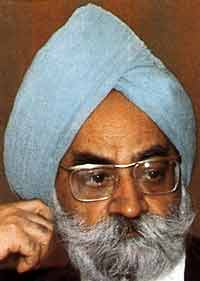 The
Dasam Granth ( By Dr. Gopal Singh)
The
Dasam Granth ( By Dr. Gopal Singh)
The Dasam Granth consists of 1428 pages. According to all available evidence, it was compiled by Bhai Mani Singh, the devout and learned Sikh custodian of the Golden Temple (who later became a martyr) 26 years after the death of Guru Gobind Singh, at Damdama. But, some historians assert that it was not the adi Granth, but his own Book that the Guru dictated to Bhai Mani Singh. However, much of its secular portion is the subject of great controversy even amongst the Sikhs who ascribe its authorship not to the Guru but to some of his 52 poets who lived at his court.
The
Contents of this Granth, which is mostly in Braj Bhasha, are (1) Jap, or meditations.
(2) Akal Ustati, or the praises of God and the denunciation of ritual, superstition
and cant, (3) Chandi Charitra, I and II, or the life of Chandi, the goddess of
war, (in Braj) (4) Var, or ballad of Durga, the exploits of the goddess of war
(in Punjabi), (5) Gyan Prabodh, or the sayings of Wisdom, which also include some
tales from Mahabharta, (6) Chaubis Avtar, or the life-stories of the incarnations
of Vishnu, according to the Hindus, and Brahrnavatar and Rudravtdr, (7) Shabd
Hazare, or devotional hymns, (8) Thirty-three Swayyas, or the praises of the one
immortal, unknowable God of wonder and grace, (9) Khalsa Mahima. or words
in praise of the Khalsa, (10) Shastra Nam-Mala; verses in praise of many arms,
(11) Charitro pkhyan or 404 tales of the wiles of women, (12) Zafar Namah (in
Persian), or letter of victory, addressed to Aurangzeb, (13) Hikayats, or legends
and tales, also in Persian, including some stories on the lines of Charitro pakhyan.
As soon as the Dasam Granth was compiled, it led to a great controversy among the Sikh divines, especially in relation to its secular portions and more notably in regard to the Charitro-pakhyan and Hikayats. It was decided to divide the book. Bhai Mehtab Singh of Mirankot (who was charged by the Panth to capture or assassinate Massa Ranghar who had then planted himself in the holy Golden Temple at Amritsar and was desecrating its sanctity) suggested to the leaders of his community that if he came back victorious in his mission, the book should be preserved in one volume, otherwise it may divided into two. Mehtab Singh was successful in putting Massa Ranghar to an ignoble death and hence the volume was preserved as it now is. This, however, as the Sikh savant, Bhai Kahan Singh points out, (See Gurmat Sudhakar, second edition, P.35) is a most arbitrary way of settling a point of such literary and theological significance. Moreover, a single man's point of view should not have prevailed, -especially of a military hero, or even a Jathedar in search of martyrdom, in preference to the viewpoint of the theologians and scholars who were still discussing the point. Several recensions of this volume are now current, some of which contain some extra hymns also. Though it is a pity that the text of the Dasam Granth has yet to be fixed by scholars and theologians, it is our considered opinion that the secular portion of what is now available in print is also the creation of the Guru himself, not only because of the internal evidence of style and diction, but also because the secular portion, including Charitro-pakhyan does not, by any chance, contradict the Guru's philosophy of a full-blooded, though detached life in all its manifestations. A supreme artist that the Guru was, he could not ignore to write about the seamy side of life, though he does not commend it anywhere.
To pick up on the Guru's extensive use of Hindu mythology, or the praises of Krishna's scintillating play on the flute, or the most sensitive portrayal of feminine beauty and charm, the inclusion of certain erotic scenes, or how, in the days of Ramayana, the Kashatryas worshipped the Brahmins, of the call of the heroes in some of the Hikiyats to bring them a cup of intoxicating wine, etc , and to disso-ciate the Guru from their authorship would be the height of artistic sacrilege. The Guru who, in his Akal Ustat (whose authorship anyhow is beyond doubt) can write this about God : "Now you are a beggar, now a King; now the reciter of the Gayatri, now the Muezzin giving "all to prayer; now the lover of own wife, now the lover of another woman; now you are the strong drink, now the drunkard," (6:16) could not but be a man of superbly catholic mind, seeing the variegated mani-festation of God in everything and everywhere. And was it not Guru Nanak who said '0 God, wondrous are those who tread Thy path and wondrous are those who are strayed away." (Var Assa). It is very difficult however, for puny, hide-bound minds to appreciate this grandeur of spiritual and aesthetic vision.
(page 268/269 - History of the Sikh People by Dr. Gopal Singh)
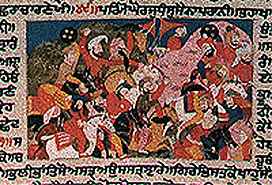 An
illustrated Dasam Granth, which contains almost all the compositions of Dasam
Patshah and some rare sakhis (narrations) of war. It may be noted that Guru Gobind
Singh Ji fought 14 battles against the enemies of the Sikh movement. We are privileged
to present to our seekers this rare painting of the "Husseini Yudh", which is
inset in the appropriate text depicting the battle. (above
painting from a rare Bir - courtesy of Dr. Chan)
An
illustrated Dasam Granth, which contains almost all the compositions of Dasam
Patshah and some rare sakhis (narrations) of war. It may be noted that Guru Gobind
Singh Ji fought 14 battles against the enemies of the Sikh movement. We are privileged
to present to our seekers this rare painting of the "Husseini Yudh", which is
inset in the appropriate text depicting the battle. (above
painting from a rare Bir - courtesy of Dr. Chan)
Those people who say that Guru Gobind Singh did not write the 'Tria-Charitra', as it is too vulgar to be called a scripture, should read the 'Kama Sutra', which is a scripture of the art of the science of love. "Kama Sutra' written nearly two thousand years ago, shows the necessity of the science of 'Kama' or 'Sex' if you prefer, to the ordinary human, in his daily life, leading to his salvation. His attainment of 'Dharma'. 'Artha', "Kaam" and eventual 'Moksha' are achieved through the above stages with the help of a sage or 'Guru', who is efficient in all the above categories.
'Kama' is the enjoyment of appropriate objects by the five senses of hearing, feeling, seeing, tasting and smelling, assisted by the mind together with the soul. The ingredient in this is a peculiar contact between the organ of sense and its object, and the concious-ness of pleasure, which arises from that contact is called 'Kama'.
Guru Gobind Singh being the perfect "Master" wanted his Sikhs to be perfect also in each and every category - hence the creation of "Tria -Chritra".
The following are some remarks by a well-known writer, Dr. Mulk Raj Anand about the greatest book ever written by Sage Vatsyayna, "Kama Sutra".
Page 23. "The strange thing is, we feel no shock, when we are ushered from the overtly non-sexual context of our daily lives into the very heart of the privacies of sex. There is no tittering reaction. And none of the titillation of Western eroticism, of the romantic novelist's insidious approach in the elaborate guilt-conscious masturbation, or the sudden assaults of rape from the pressure of exorcised violences, themselves emerging from the prolonged repression through the 'original sin' legend of Adam and Eve eating the fruit and being turned out of the garden of Eden. There is hardly any trace of the boring soul-less life of the brothel.
How is it, then, that in this book of all books about sex, we feel no surprise at the meeting of the four eyes, the penetration of the lingam into the yoni, and the interlocking of two separate organisms in embrace?
Why are these unions, recommended by Vatsyayana, different from the kind of furtive connection which takes place from complete ignorance of the feelings of each other, and from the denial of the body-souls, by those who are ashamed of the dream tryst?
I believe that not only did Vatsayana's book come after several sacred compilations about the rituals of love making, but it enshrined the essences of two thousand years or more of the worship of love. He made love holy."
Page 25. "The phase of consciousness of those early periods must be understood if we are to appreciate the epic "Kama Sutra" and inherit from it, without false shame and sniggering, the reassurance that a natural attitude towards sex, as something sacred, is possible, if the hearts are cleansed and restored to the relative innocence of our true human nature."
Page 26 "The sex act became the sacred means of salvation itself, the fusion of man and woman, where 'each becomes both'. And, together they are freed of all bonds, and merge with the cosmos."
"In the two great epics of India, the Ramayana and the Mahabharata, which recreate the desire images of what men and women ought to be, we see the spontaneous urges of the people for free love, and the worship of sex symbols, as the sources of fulfillment, transformed into a prescribes ritual as part of the Hindu Dharmic order."
Page 31. "But there is no doubt about the fact that the art of love had been thought about from very ancient times, Nandikeshvara's thousand chapters may have been thought a thousand years before Christ. The five hundred chapters of Shvetaketu from Nandikeshvara's thousand chapters may have been put down about the time when the 'Chandogya' and the 'Brihadranyaka Upanishad' were compiled, just before the seventh century BC., because this Shvetaketu is referred to in both these 'Upnishads'."
Page35. The bard Kalidasa was to reproduce the inner curves of creative freedom of that time, infusing into narrative, sanctioned by the gods in his prologue, the deep sacredness of feeling. In freeing the poetry from the shackles of orthodoxy, the oppression of taboo was being replaced by the sense of humanity. This poet of the classical renaissance has perhaps given the intensest expression of free love in his poems and plays."
Page 37. In Jayadeva 'Geet Govinda' in the twelfth century, which was one of the symbolic representation of the loves of Krishna and Radha, revived through the "Bhakti' cults of devotion to the god of happiness, we reach the acme of expression of mutable love moods."
Page 40 Rabindranath Tagore, in many love poems he wrote, he had only one cure for passion. He said: "A thousand year's effort is worthwhile to win a woman's heart."
And in the end Mulk Raj Anand writes, "The ethos of Vatsyayana about love between man and woman, put by the sage at the end of his book, has to be learnt again: "Desire, which springs from nature and which is increased by art, from which all danger is taken away by wisdom, becomes firm and secure."
These were just a few extracts from the great volume of 'Kama Sutra', which shows the art of love in a very sacred form. Those people, who look at sex or Kaam as a destructive force, are advised to read this book.
No doubt 'Kaam' in Sikhism is one of the vices of life - but something which is an integral part of life, and when used sensibly can be a person's passport to eternal peace.
For more information, I would advise the reader to read the books on sex and meditation by Osho Rajneesh, especially "Sambhogh se Samadhi ki Or" and "Kaam Vaashna".
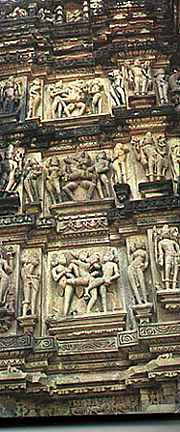
The sex images sculptured on the doorways of the temples are a symbol of a culture, rich with tradition in a sacred and divine atmosphere of prevailing life. Most of the temples in the south have these unique images and sculptures. The ruins of Khajuraho, Karnatka and other sites have discovered more of these type of "sexual images" - signifying that it was not a subject of 'taboo' as some narrow-minded people think now-a-days, but a necessity of life, leading to bliss and salvation, under the guidance of a proper sage or Guru.
For more information on the authenticity of the Dasam Granth see some more proofs.
We present an article from one of the UPNISHADS and show the reader what exactly SEX was considered in the olden times. Those people who say that Guru Gobind Singh did not write the Tria Charitra, should make note of this and realise that Sex might be 'taboo' to them but in fact it was an essential part of a human being in reaching salvation.
According to the Brhadaranyaka Upanisad, sexual
union is the highest kind of ritual sacrifice. This sacred text says that it was
the Great Creator God Himself who first performed this sacrifice when he created
woman:
Having created her, he worshipped her sexual organ;
Therefore
a woman's sexuality should be worshipped.
He stretched forth from himself
a stone for pressing nectar
[i.e., causing a woman's sexual fluid to flow]
And impregnated her with that.
Her lap is the sacrificial altar;
Her hair, the sacrificial grass;
Her skin the soma press;
The depths
of her sexual organ, the fire in the middle
. . . . . . . . . . Many mortals...go
forth from this world...without merit,
Namely, those who practice sexual union
without knowing this.
Brhadaranyaka Upanisad 6.4.1-4
Nowhere is
this dictum followed in spirit and soul more than in the canons of Buddhist iconography.
In such representations, the mother is often shown in a posture with both legs
around the father's waist. In this remarkable and richly symbolic manifestation,
both appear simultaneously united and independent, like the complex relationship
of sameness and difference between wisdom (female) and compassion (male) in the
enlightened state. Ponderous, energetic forms confront the viewer in this stunning
portrayal. Sitting on a full-blooming lotus, they embrace with passion, her lips
seeking his. She gazes rapturously and intently at her consort with her head thrown
back, heightening their electrifying aura.
She is totally nude except for
some gold jewellery on her arms, a skull crown and a girdle with tassels made
of gemstones. With her right had she beats out a damaru (hand drum). The damaru
has sexual connotations and its two sides represent the male and female respectively.
Her other upraised hand bears a skull cup. As the libation vessel of the Tantric
practitioner, the skull cup essentially parallels the clay pot (kumbha in Sanskrit)
of the Vedic sacrifice, the alms bowl of the Buddha, and the sacred water vase
(Kalasha in Sanskrit) of the bodhisattvas.
Tantric Buddhism is unique among
Buddhist sub-traditions in its acceptance of the body and sense experience as
sources of knowledge and power. Tantric Buddhists eulogise the body as an "abode
of bliss" and boldly affirm that desire, sexuality, and pleasure can be embraced
on the path to enlightenment. In keeping with this life-affirming orientation,
the movement upholds the possibility of liberating relationships between men and
women and envisions co-operative yogic methods that men and women can perform
together in order to transform the ardour of their intimacy and passion into blissful,
enlightened states of awareness. This mood of exuberant delight, graceful sensuousness,
and reciprocity that often characterises the sculpted and painted couples also
suffuses the literary descriptions in the Tantric texts, which exult in an open
and unashamed affirmation of sensuality in a religious context:
Therefore,
one who desires Buddhahood
Should practice what is to be practiced.
To
renounce the sense objects
Is to torture oneself by asceticism-don't do it!
When you see form, look!
Similarly, listen to sounds,
Inhale scents,
Taste delicious flavors,
Feel textures.
Use the objects of the five senses
-
You will quickly attain supreme Buddhahood.
... Candamaharosana-tantra
With their radiant and desirable pink-hued bodies, these deities seem to
be saying just the same thing.
SOME MORE PROOFS
According
to the Sikh Rahit Maryada, only the first twenty-five stanzas of the Benati Chaupai16
should be recited, whereas the Damdami Taksal insists on twenty-nine. In line
with this argument, the 3HO ("Healthy, Happy, Holy Organization") leader,
Harbhajan Singh Khalsa challenges the orthodox standpoint as follows: "One
who recites Chaupai without Arril lives in pain and unhappiness."17
In order to understand the real
issues involved in this debate, we need to examine the content of the extra four
stanzas of the Benati Chaupai. Originally, the Benati Chaupai'8 forms part of
a section called Pakhyan Charitar ("Tales of the Wiles of Women") in
the Dasam Granth. This whole section is a collection of legendary narrative and
popular anecdotes concerning the psychology of women.19 Most of the Singh Sabha
scholars consider it highly problematic and try to avoid potentially embarrassing
questions. Our main concern here is to look at the following four stanzas which
are excluded from the standard version of the Chaupai:
kirpa
kari ham par jagg mata. granth kara puran subh rata.
kilavikh sakal deh ko
harta. dusht dokhian ko chhai karta. (26)
sri asidhuj jabb bhae diala. puran
kara granth tatakala.
man banchhat phal pavai soi. dukkh na tisai biapat hoi.
(27)
Arril.
sunai gung joyahi su rasana pavai. sunai murh chitti lai chaturata
avai.
dukkh darad bhau nikat na tin nar ke rahai. ho jo yakhi ek bar chaupai
ko
kahai. (28)
sammat sattrahi sahas bhannijje. arad sahas phuni tin kahijje.
bhadrav sudi astami ravivara. tir sattadrav granth sudhara. (29)
Iti sri charitro pakhyaney triya charitrey bhoop mantri sambandey chaar sey chaar charitter samaptam sat subham sat. (404-7539-samapatam)
The
[divine] Mother of the World bestowed her grace on us. Thus the Granth was completed
in an auspicious manner. The Lord removed all the bodily afflictions. The Creator
destroyed all our wicked enemies. (26)
When the Lord of a Sword-on-His-Banner
became compassionate: The Granth was completed instantly! He [who receives the
divine grace] alone achieves the desired goal (phal, "fruit") of his
life; and no pain can affect him in anyway. (27)
Arril [the Syllable Metre].20
The dumb that listens [to this Chaupai] receives the tongue! The stupid who listens
with attention receives wisdom! Pain, grief and fear cannot even touch that person,
who recites the Chaupai only once, O Man! (ho!, "Yea!") (28)
First,
the sambat seventeen hundred should be said; then one-half of a hundred and three
should be added [to make the sambat 1753 or 1696 CE]. It was Sunday on the eighth
day of light moon in the month of Bhadon (August/September), when the Granth was
completed on the bank of river Sutlej. (29)
Here
the sri charitro pakhyan - the dialogue between the king and his minister ends
and 404 charitters have come to an end with the grace
of the Almighty.
Evidently, these stanzas provide important historical information about the completion of the text of Pakhyan Chritar in sambat 1753 or 1696 on the bank of Sutlej river at Anandpur Sahib.
This Chaupaee is one of the 5 Banis recited when Amrit is made. The stanzas which come after 25 are ommitted for the reasons above, but stanzas 26 to 29are enough evidence to prove that the Tria Charitter is the bani of Guru Gobind Singh in the Dasam Granth.This bani cannot be denied under any circumstances as it is the basis of the Khalsa Panth - as no Sikh can be called a Khalsa of Guru Gobind Singh until he/she has been baptised by the amrit made by the recitation of THIS bani. Can the Khalsa who has taken this Amrit deny this fact and condemn the bani of his Satguru?
We present the hand written note of Guru Gobind Singh Ji mentioning his banis of the Granth:-
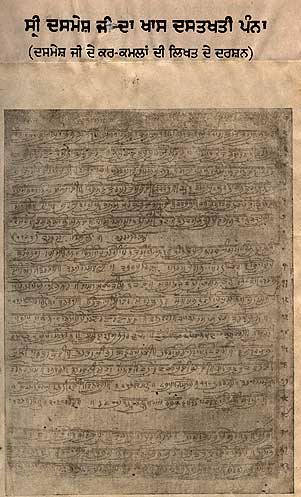
This page taken from a bir in Patna Sahib
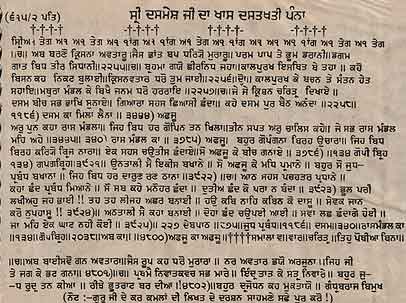
The readable note of Guru Gobind Singh
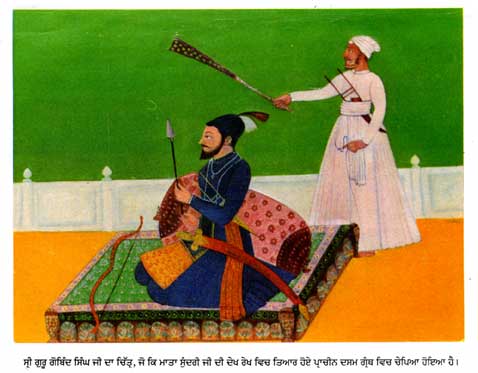
A very old painting of Guru Gobind Singh Ji which is fixed in a Dasam Granth manuscript which was ordained by Mata Sundari Ji (wife of Guru Gobind Singh Ji) (from 'Gobind Sagar' bu Pyara Singh Padam)
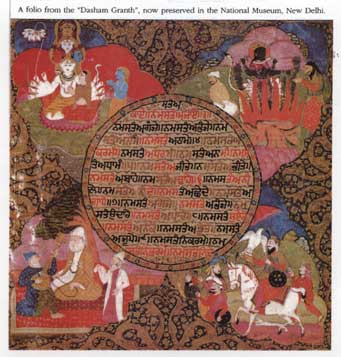
We present an article by Khushwant Singh written in 1989 regarding the views of Osho Rajneesh
Kama to Rama
There are many ways of attaining godhood, say teachers of religion. Acharya Rajneesh disagrees and says there is only one way and sexual intercourse is the first step towards it. He maintains that religion as it is practised, is false, and its propagators are agents of Satan. They have degraded love and taught us the negation of life. The philosophy of religion has always been death-oriented instead of being life-oriented. He goes on to add: 'I call religion the art of living. Religion is not a way to undermine life; it is a medium for delving deeply into the mysteries of existence. Religion is not turning one's back on life; it is facing life squarely. Religion is not escaping from life; religion is embracing life fully. Religion is the total realization of life.'
Since love is the essence of all religions and sex the essence of love, you cannot sidestep it to proceed on your voyage of discovery. Rajneesh writes, 'Sex is the beginning of the journey to love. The origin, the Gangotri of the Ganges of Love, is sex, passion—and everybody behaveslike its enemy. Every culture, every religion, every guru, every seer has attacked^this Gangotri, this source, and the river has remained bottled up. The hue and cry has always been, "Sex is sin. Sex is irreligious. Sex is poison." But we never seem to realize that ultimately, it is the sex energy itself that travels to and reaches the inner ocean of love. Love is the transformation of sex energy.'
Because sex has been condemned and suppressed, 'it has become an obsession, a disease, a perversion', says the Acharya, and advises us to 'accept sex with joy. Acknowledge its sacredness . . . When a man approaches his wife he should have a sacred feeling, as if he were going to a temple. And when a wife goes to her husband she should be full of the reverence one has nearing God. In the moments of sex, lovers pass through coitus, and that stage is very near to the temple of God, to where he is manifest in creative formlessness.' He conjectures that man had his first glimpse of samadhi during sexual intercourse culminating in a climax when the mind becomes empty of thoughts. Thus vishyanand (bliss of coitus) and Brahmanand
(bliss of union with God) are much the same; one is ephemeral, the other eternal.
Not all sexual intercourse is experience of divinity. For that you have to first get rid of your ego—'Unless I dissolve myself, how can the other unite with me?' he asks. Love always gives; the ego is ever the grabber; love is motiveless, the ego always motivated; the ego only understands the language of taking; the language of giving is love. The second condition to be fulfilled is the feeling of timelessness. 'In orgasm, the sense of time is non-existent. There is no past, no future, there is only the present moment.'
The Acharya has some practical suggestions to overcome an unhealthy obsession with sexuality. Children should be allowed to remain nude as much as possible in the home so that they do not develop prurient curiosity in private organs. They should also be taught to meditate (on what, he does not say) in silence for at least one hour every day. They should be taught what sex is all about before they are old enough to engage in it. He writes, 'Sex is the most mysterious, most profound, most precious and,at the same time, the most accursed subject; and we are in total darkness about it. We never pay our attention to this important phenomenon. A man goes through the routine of coitus throughout his life, but he does not know what it is.'
The Acharya, who claims to have had sexual fulfilment in his previous life which cleared his mind of sexuality for his present incarnation and those to come, tells us how to get the best out of coitus. Most of us are used to quickies which end in frustration and incite us to have more of the same thing. Coitus, he tells us, must be prolonged as much as possible. In the way of techniques, he suggests slowing down one's breathing and focusing awareness to a point between the eyes, the seat of the agnichakra. If you can prolong intercourse to one hour, you need not think of sex for the rest of your life; if you can prolong to three hours, you will be liberated from sexuality for your lives to come. A third essential condition is that you should approach sex with reverence. 'Give sex a sacred status in your life,' he says. 'At the time of coitus, we are close to God.'
The Acharya tells us the sculptors of erotica
on the temples of Konark, Khajuraho and Puri had the right approach to sex. We should have such temples all over India. Tantriks were also on the right path; preachers of religious dogma suppressed them. He concludes: 'The journey to kama is also the journey to Rama. The journey to lust is also the journey to light. The tremendous attraction for sex is also the search for the sublime.'
It is difficult to decide how seriously one can take Rajneesh. As anything else he writes, his From Sex to Super-Consciousness is extremely readable.
Sunday, 12 August 1989
From 1895 to 1897, different scholars and theologians assembled at the Akal Takht, Amritsar, to study the 32 printed Dasam Granths and prepare the authoritative version. They met at the Akal Takhat at Amritsar, and held formal discussions in a series of meetings between 13 June 1895 and 16 February 1896. A preliminary report entitled Report Sodhak (revision) Committee Dasam Patshah de Granth Sahib Di was sent to Sikh scholars and institutions, inviting their opinion. A second document, Report Dasam Granth di Sudhai Di was brought out on 11 February 1898. Basing its conclusions on a study of the old handwritten copies of the Dasam Granth preserved at Sri Takht Sahib at Patna and in other Sikh gurudwaras, this report affirmed that the Holy Volume was compiled at Anandpur Sahib in 1698[2] . Further re-examinations and reviews took place in 1931, under the aegis of the Darbar Sahib Committee of the Shiromani Gurdwara Prabhandak Committee they too vindicated the earlier conclusion (agreeing that it was indeed the work of the Guru) and its findings have since been published. Following were the members of the 1895-1897 Sodhak (Revision) Committee (along with their credentials) that was formed for analysis of Dasam Granth[3]
- Bhai Manna Singh Hakim, Secretary Gurmat Granth Pracharak Sabha. Had knowledge of English, Persian and Gurmukhi grammar
- Bhai Narain Singh, Teacher and Persian Scholar
- Bhai Thakar Singh, Clerk Municipal Committee. Proficient in Persian and Gurmukhi. Had knowledge of 'Pingal' (science of poetry)
- Bhai Hazura Singh, Ragi Sri Darbar Sahib Amritsar, and Secretary Sangat Lakar Mandi
- Bhai Dharam Singh, Member Khalsa Sat Sangat Sabha
- Bhai Sant Singh, Gurmukhi Teacher
- Bhai Darbara Singh, Proficient in English and Gurmukhi (Grandson of Giani Gian Singh)
- Bhai Jaidial Singh, Middle pass, Teacher MB Branch School
- Bhai Gurdial Singh, Gurmukh Person
- Bhai Kishan Singh Ji and Bhai Ram Singh, Rice Dealers, Members Sat Sangat Sabha
- Bhai Narain Singh, Secretary Khalsa Sat Sangat Sabha
- Bhai Thakur Singh, Member Sat Sangat Sabha
- Bhai Partap Singh, Secretary Khalsa Vidyarathi Sabha
- Bhai Bhagwan Singh, Secretary Sangat Chaursti, Attari
- Bhai Harnam Singh, Member Khalsa Vidyarathi Sabha
- Bhai Harnam Singh, Clerk, Kila Gobindgarh
- Bhai Boorh Singh, Secretary Sangat Katra Kalan
- Bhai Tek Singh, Secretary Sangat Dauk Baba Sahib
- Bhai Ram Singh Attar
- Bhai Makhan Singh, Sweet Maker
- Bhai Gurdial Singh
- Bhai Ghanaya Singh
- Bhai Teja Singh
- Etc.
Internal evidence in the 'Dasam Granth Sahib'to the dates of compilation of different portions of various compositions
- ਸੱਤ੍ਰਹ ਸੈ ਪੈਤਾਲ ਮਹਿ ਸਾਵਨ ਸੁਦਿ ਥਿਤਿ ਦੀਪ ॥ ਨਗਰ ਪਾਂਵਟਾ ਸੁਭ ਕਰਨ ਜਮਨਾ ਬਹੈ ਸਮੀਪ ॥2490॥
- (This work has been completed) in the year 1745 of the Vikrami era in the Sudi aspect of the moon in the month of Sawan, (July 1688 A.D.) in the town of Paonta at the auspicious hour, on banks of the flowing Yamuna. (Sri Guru Gobind Singh Sahib in 'Krishnavtar')
- ਸੱਤ੍ਰਹ ਸੈ ਪੈਤਾਲ ਮੈ ਕੀਨੀ ਕਥਾ ਸੁਧਾਰ ॥ ਚੂਕ ਹੋਇ ਜਹ ਤਹ ਸੁ ਕਬਿ ਲੀਜਹੁ ਸਕਲ ਸੁਧਾਰ ॥੭੫੫॥
- In Samvat 1745 (1688 A.D.), this 'katha' (composition) was improved and if there is any error and omission in it, then the poets may still improve it.755. (Sri Guru Gobind Singh Sahib in 'Krishnavtar')
- ਸੰਬਤ ਸਤ੍ਰਹ ਸਹਸ ਭਣਿਜੈ ॥ ਅਰਧ ਸਹਸ ਫੁਨਿ ਤੀਨਿ ਕਹਿਜੈ ॥ ਭਾਦ੍ਰਵ ਸੁਦੀ ਅਸਟਮੀ ਰਵਿ ਵਾਰਾ ॥ ਤੀਰ ਸਤੁਦ੍ਰਵ ਗ੍ਰੰਥ ਸੁਧਾਰਾ ॥405॥
- The Granth was completed on Sunday, the 18th day of month of Bhadon, in 1753 Bikrami Sammat (September 14, 1696 A.D.) on the banks of river Satluj.(Sri Guru Gobind Singh Sahib in 'Charitropakhyan')
- ਸੰਮਤ ਸੱਤ੍ਰਹ ਸਹਸ ਪਚਾਵਨ॥ ਹਾੜ ਵਦੀ ਪ੍ਰਿਥਮੈ ਸੁਖ ਦਾਵਨ ॥ ਤ ਪ੍ਰਸਾਦਿ ਕਰਿ ਗ੍ਰੰਥ ਸੁਧਾਰਾ ॥ ਭੂਲ ਪਰੀ ਲਹੁ ਲੇਹੁ ਸੁਧਾਰਾ ॥860॥
- This Granth has been completed (and improved) in Vadi first in the month of Haar in the year 1755 Bikrami (July 1698); if there has remained any error in it, then kindly correct it.(Sri Guru Gobind Singh Sahib in 'Ramavtaar')
- ਸਤ੍ਰਹ ਸੈ ਚਵਤਾਲ ਮੈ ਸਾਵਨ ਸੁਦਿ ਬੁਧਵਾਰ ॥ ਨਗਰ ਪਾਵਟਾ ਮੋ ਤੁਮੋ ਰਚਿਯੋ ਗ੍ਰੰਥ ਸੁਧਾਰ ॥੯੮੩ ॥
- This (part of the) Granth has been prepared after revision in Paonta city on Wednesday in Sawan Sudi Samvat 1744 (August 1687 AD). 983.(Sri Guru Gobind Singh Sahib in 'Krishnavtar')
THIS DAS GRANTHI CONTAINS SOME RARE BANIS OF GURU GOBIND SINGH JI (IN PDF FORM)
